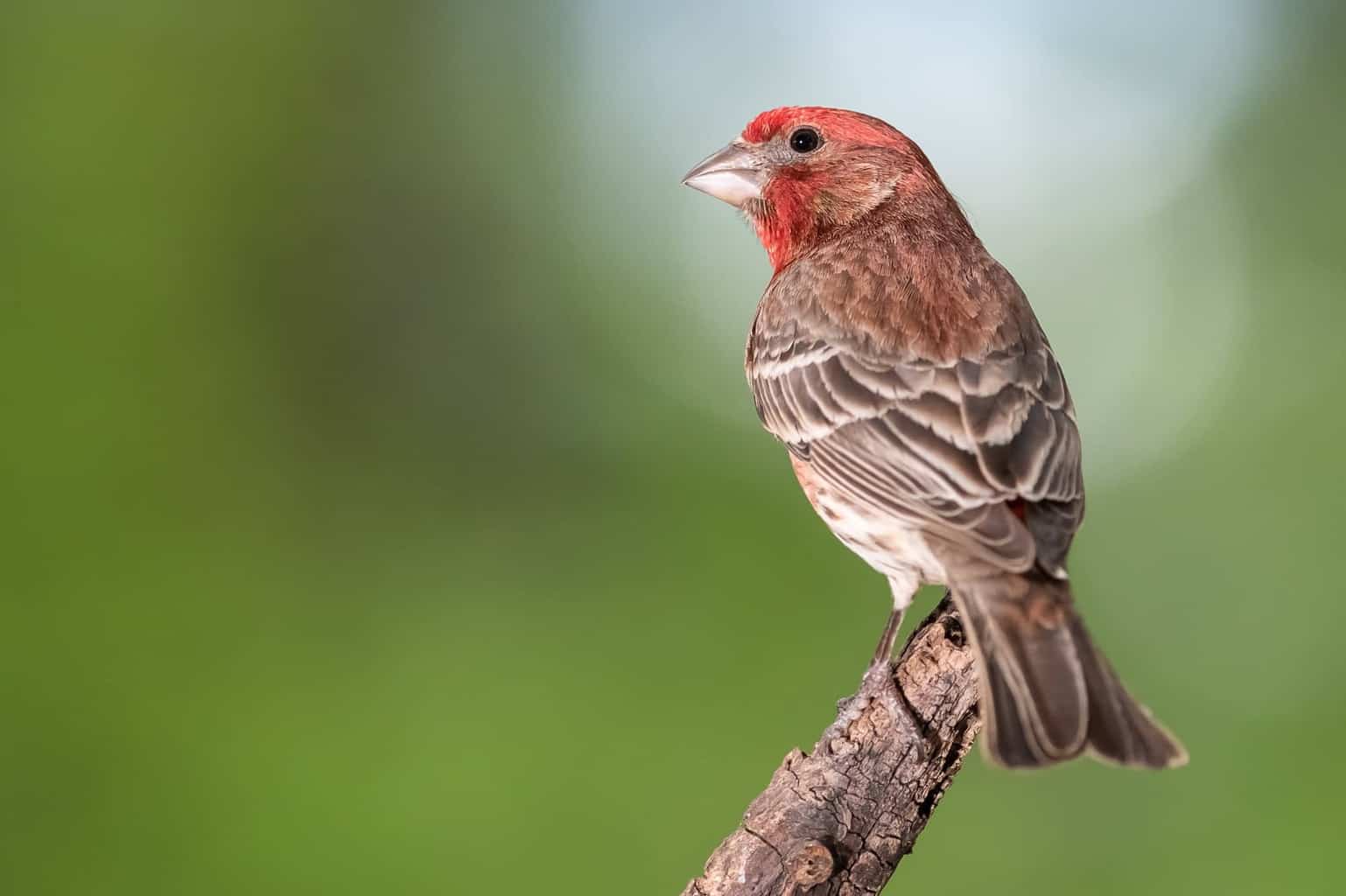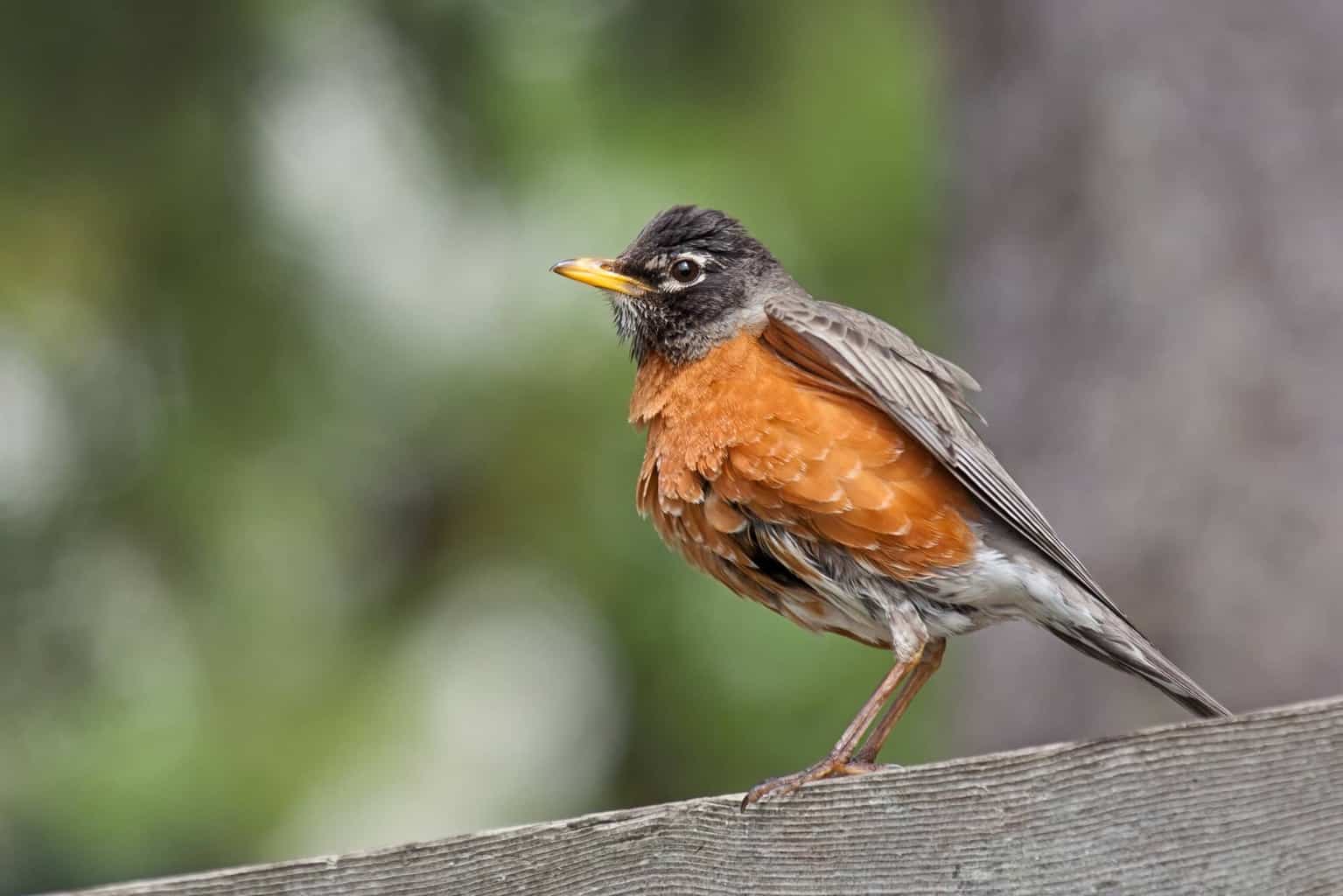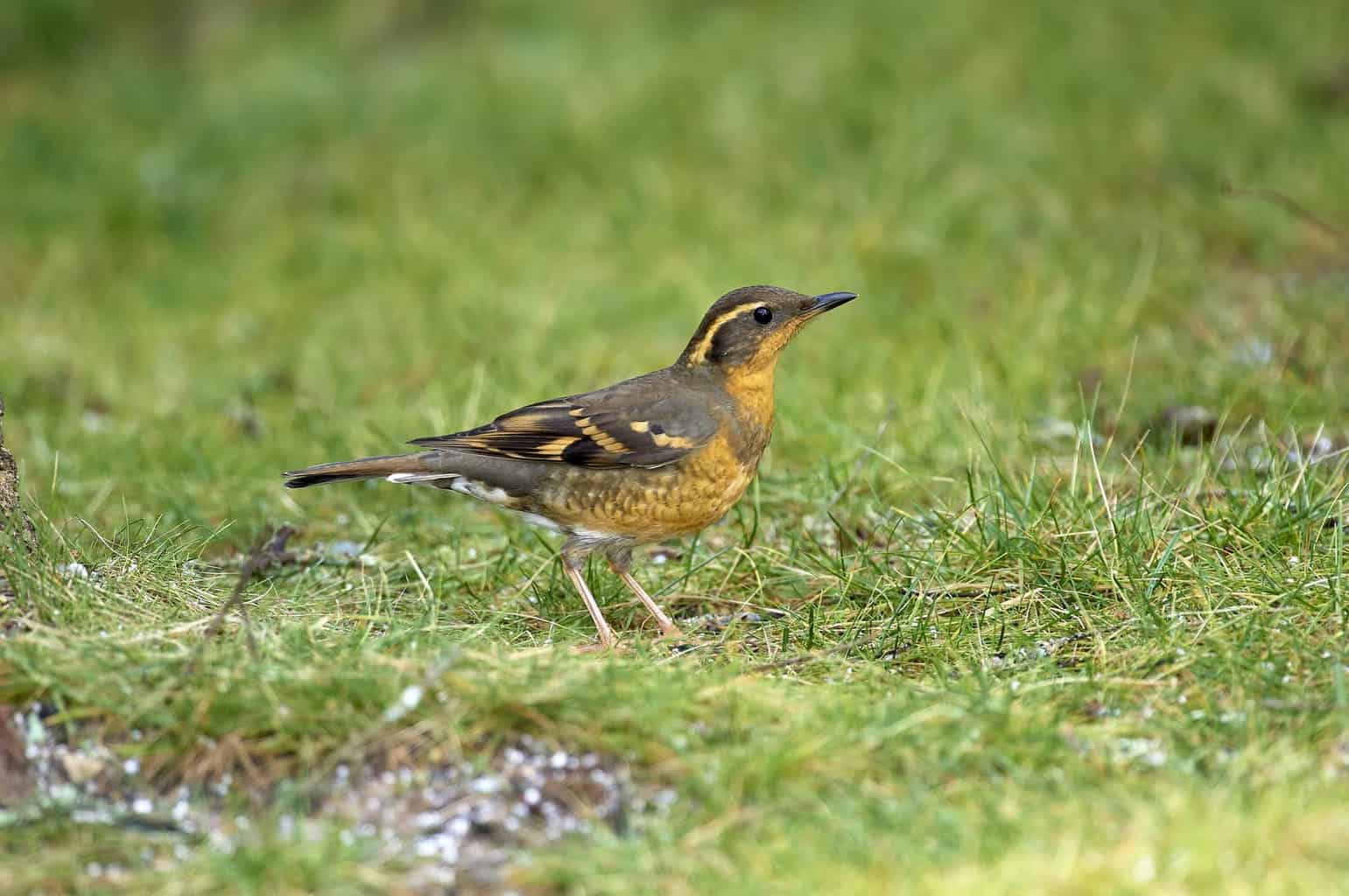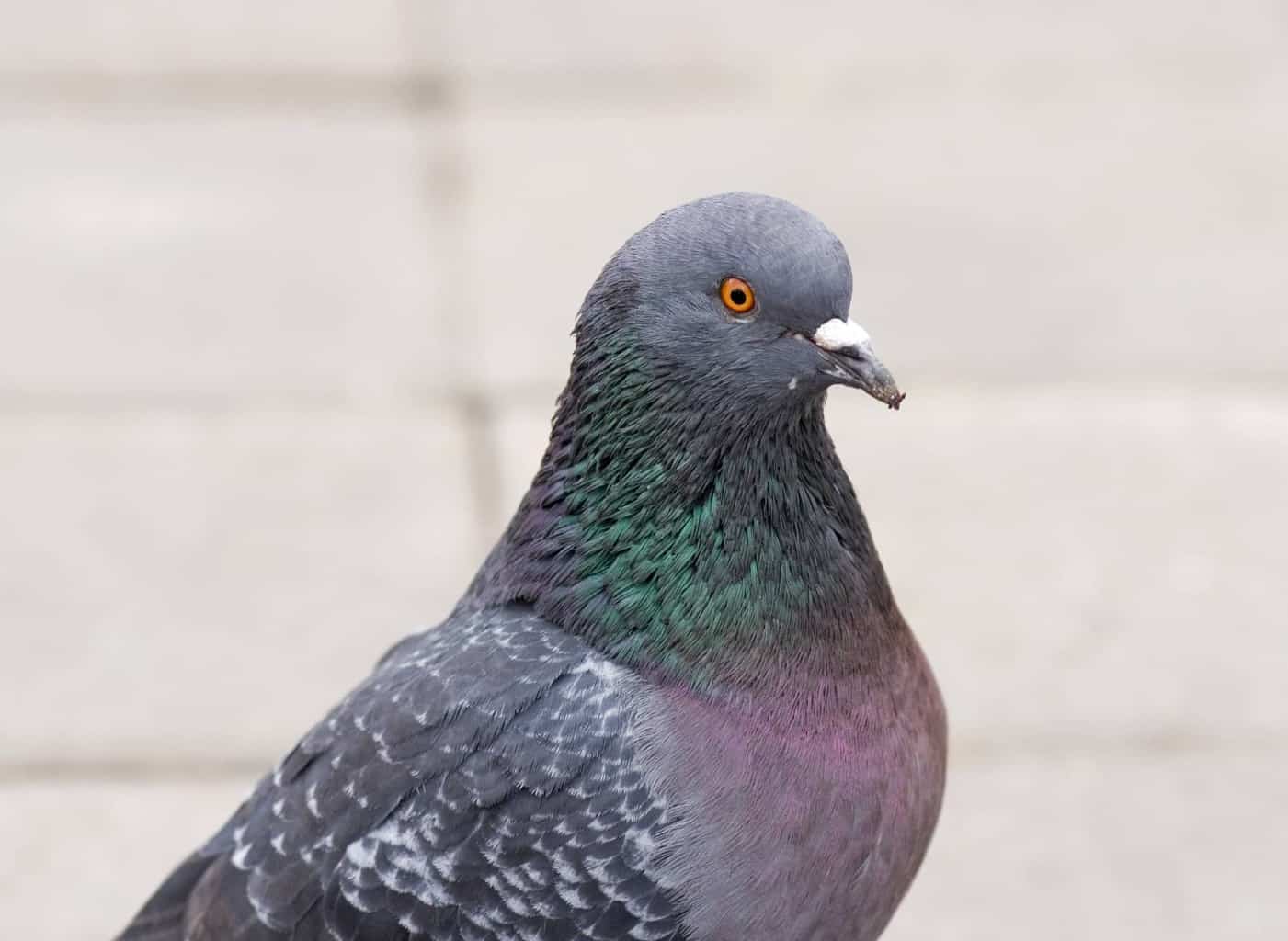According to the South Dakota Ornithologists Union (SDOU), 438 recorded bird species live in the Mount Rushmore State.
This figure is slightly larger than its northern counterpart, which currently has anywhere between 375 to 415 documented species of birds. If you’re interested in knowing more about the types of birds in South Dakota, you’ve come to the right place!
In today’s article, we’ll discuss some of the most impressive and colorful birds that you can find in South Dakota. Let’s jump right in!
Red Birds in South Dakota
Northern Cardinal

- Scientific Name: Cardinalis cardinalis
- Length: 8.3 to 9.1 In
- Weight: 1.5 to 1.7 oz
- Wingspan: 8.9 to 12.2 In
Kicking off the list is one of the most impressive and unique birds that you can find in North America. The Northern Cardinal is typically found during the breeding season in South Dakota.
The bird is easily identifiable thanks to the bright red plumage covering most of the bird’s body, except for the black face mask. Females of the same species are mostly pale brown with the same red crest on the bird’s head.
House Finch

- Scientific Name: Haemorhous mexicanus
- Length: 4.9 to 6.1 in
- Weight: 0.6 to 0.9 oz
- Wingspan: 8.1 to 10.5 in
The American House Finch is among the most common birds across the country and is quite common in South Dakota (dive into the charm of South Dakota’s 15 finches in our article).
These finches have a rosy red color covering most of the bird’s plumage at the head and wings. Females of the species are quite different, as most of their body is gray and pale brown.
Red-winged Blackbird

- Scientific name: Agelaius phoeniceus
- Length: 6.7 to 9.1 in
- Weight: 1.1 to 2.7 oz
- Wingspan: 12.2 to 15.8 in
The Red-winged Blackbird is among the most popular species of blackbirds in all the United States.
The bird is known for its impressive shiny black plumage and the characteristic yellow and red patch found on each of the bird’s black wings. Females are typically brown with heavy streaking all over their bodies.
Red-winged Blackbirds are typically found around bodies of water, such as marshes and wetlands. They’re also more attracted to backyards with bird fountains.
Downy Woodpecker

- Scientific Name: Dryobates pubescens
- Length: 5.5 to 7.1 In
- Weight: 0.7 to 1.1 oz
- Wingspan: 9.8 to 12.2 In
There are plenty of woodpecker species in South Dakota. However, the most common bird by far is the Downy Woodpecker. Additionally, it’s also the smallest species of woodpeckers in all of the United States.
Although most of the bird’s body is white and black, the most characteristic feature of the bird is the red patch on the bird’s nape.
These birds are adapted to living around humans and can often be found nesting in man-made bird boxes.
Hairy Woodpecker

- Scientific Name: Dryobates villosus
- Length: 7.1 to 10.2 in
- Weight: 1.4 to 3.4 oz
- Wingspan: 13.0 to 17.0 in
The Hairy Woodpecker is also abundant in the state of South Dakota. The bird has a striking similarity to the Downy Woodpecker, which makes them quite tricky to tell apart.
However, Hairy Woodpeckers are a little larger and have a bigger bill. Both birds have the same diet, so you can attract them with a variety of seeds and leftover food remains.
Blue Birds in South Dakota
Blue Jay

- Scientific Name: Cyanocitta cristata
- Length: 8.6 to 11.8 in
- Weight: 2.5 to 3.5 oz
- Wingspan: 13.3 to 16.9 in
There aren’t many blue-colored birds as iconic and unique as the Blue Jay. Although the bird is known for being loud and annoying to some people, they have one of the most beautiful shades of blue in birds to make up for it.
This unique cyan color isn’t produced by pigments. Instead, it’s a reflection created by the feathers’ structure, adding to the bird’s uniqueness.
Blue jays are surprisingly intelligent and can imitate the sounds of raptors to warn other birds. They only know how to crack nuts open, a rarity among birds.
Eastern Bluebird

- Scientific Name: Sialia sialis
- Length: 6.3 to 8.3 In
- Weight: 0.9 to 1.2 oz
- Wingspan: 9.8 to 12.6 In
The Eastern Bluebird is known for its brilliant blue color, which typically covers most of the bird, including its wings, back, head, and tail.
These birds are relatively similar to Western Bluebirds. However, you can distinguish the eastern variety by the reddish-brown feathers covering most of the bird’s white underparts and the throat.
Barn Swallow

- Scientific Name: Hirundo rustica
- Length: 6.7 to 7.5 inches
- Weight: 0.56 to 0.78 ounces
- Wingspan: 12.6 to 13.6 inches
Another relatively common blue-colored bird in South Dakota is the Barn Swallow. This bird is one of the most common swallow species in the country.
The familiar bird has a steely blue plumage covering its back, and it likes to live in large groups. As the name suggests, Barn Swallows like to live around barns and meadows, preferably in huge groups, and feed mainly on insects.
Common Grackle

- Scientific name: Quiscalus quiscula
- Length: 11.0 to 13.4 in
- Weight: 2.6 to 5.0 oz
- Wingspan: 14.2 to 18.1 in
The Common Grackle belongs to the family of American blackbirds, which explains the bird’s resemblance to a common blackbird.
However, this one is unique because it has an iridescent brown and purple body with a shiny blue head and contrasting white eyes.
Green Birds in South Dakota
Ruby-throated Hummingbird

- Scientific Name: Archilochus colubris
- Length: 2.8 to 3.5 in
- Weight: 0.1 to 0.2 oz
- Wingspan: 3.1 to 4.3 in
The Ruby-throated Hummingbird is the only hummingbird species that lives and breeds in South Dakota. Not only that, but it’s also one of the very few backyard birds in the state with a rich green primary color.
The majority of the bird’s body is bright green. However, the bird’s most characteristic feature is the ruby-red plumage covering the male’s throat.
Violet-Green Swallow

- Scientific name: Tachycineta thalassina
- Length: 4.5 to 5.0 in
- Weight: 0.4 to 0.6 oz
- Wingspan: 10.1 to 11.0 in
The Violet-green Swallow is one of the most beautiful birds that you can find in South Dakota. This bird has a dark smooth green plumage that covers the majority of the bird’s back and head.
The rump area has a deep violet or purple color that makes the bird extremely attractive and unique. Violet-green Swallows like to live in large groups and enjoy perching on large trees and communication wires.
Orange Birds in South Dakota
Baltimore Oriole

- Scientific Name: Icterus galbula
- Length: 5.8 to 7.8 in
- Weight: 2.3 to 3.5 oz
- Wingspan: 3.5 to 4.7 in
When it comes to orange-colored birds, none is brighter than the Baltimore Oriole in South Dakota. Although it isn’t the most common orange-colored bird, it’s still the most brilliant and vibrant.
The bird has a flaming orange color covering most of its underparts, including the shoulder and rump in male birds. Females and juveniles have similar patterns and colors but are much less vibrant than adult males.
American Robin

- Scientific Name: Turdus migratorius
- Length: 9.0 to 11.0 In
- Weight: 2.3 to 2.8 oz
- Wingspan: 14.7 to 16.5 In
The American Robin is one of the most common backyard birds in South Dakota. In fact, it’s the most common constant resident bird of the state, which is a title that the Robin holds in multiple neighboring states.
Besides residential areas, the bird also lives in forests, and they’re easily identifiable due to the reddish-orange plumage covering their underparts and breasts. The rest of their body is covered with black feathers.
The bird is highly adapted to urban parks and spaces and is friendly towards humans. American Robins lay unique and beautiful sky blue eggs.
Varied Thrush

- Scientific Name: Ixoreus naevius
- Length: 7.5 to 0.2 In
- Weight: 2.3 to 3.5 oz
- Wingspan: 13.1 to 15.3 In
The Varied Thrush has a decent level of resemblance to American Robins. They both have a similar shade of bright rusty orange that covers the bird’s belly.
However, there are a few other distinctions between the two. For example, the Varied Thrush is smaller than the Robin and has a bluish-gray plumage at the shoulder and upper back.
The Varied Thrush is also stockier and has an orange patch extending from the bird’s wings up to its eyes. Another distinction is that Thrushes are aggressive and may compete with other birds to keep them at bay, while American Robins are relatively peaceful.
Yellow Birds in South Dakota
American Goldfinch

- Scientific Name: Spinus tristis
- Length: 4.3 to 5.5 in
- Weight: 0.39 to 0.71 oz
- Wingspan: 7.5 to 8.7 in
The American Goldfinch is easily the most common yellow-colored bird in South Dakota and the majority of the United States.
The bird is easily identifiable and typically hangs around bird feeders in residential areas. The American Goldfinch has a bright golden yellow plumage that covers the bird’s underparts and the back and face.
Another characteristic feature of the bird is the black cap covering its head and wings, which is only visible in males and distinguishes them from females. In addition to the absence of the black cap, females have a generally fainter color than males.
American Yellow Warbler

- Scientific Name: Setophaga petechia
- Length: 4.7 to 5.1 inches
- Weight: 0.3 to 0.4 ounces
- Wingspan: 6.3 to 7.9 inches
North America has a vast range of warblers grouped under the family of New World Warblers. These birds have bright yellow plumage.
One of the most popular warblers is the American Yellow Warbler. This shy and elusive bird typically lives in forests and around lakes.
It’s known for its faint olive-green upperparts and bright yellow coat over the rest of its body.
Western Meadowlark

- Scientific Name: Sturnella neglecta
- Length: 6.3 to 10.2 in
- Weight: 3.1 to 4.1 oz
- Wingspan: 16.0 to 16.3 in
Although the Western Meadowlark is North Dakota’s official state bird, it’s also quite common in South Dakota.
The Western Meadowlark is a midsized species roughly as large as an American Robin. The bird mainly lives and breeds in grasslands. It has a slender and long bill and a broad-shouldered posture.
Both male and female Western Meadowlarks have a yellow and brown body, with the yellow part covering the bird’s underpart and extending from the throat to the bird’s belly.
Yellow-Headed Blackbird

- Scientific Name: Xanthocephalus xanthocephalus
- Length: 8.3 to 10.2 in
- Weight: 1.6 to 3.5 oz
- Wingspan: 16.5 to 17.3 in
Another bird common in both North and South Dakota is the Yellow-headed Blackbird.
As you might’ve expected from the bird’s name, the Yellow-headed Blackbird has yellow feathers covering almost all of the bird’s head and extending down to the bird’s chest. Females only have yellow on their throats.
In both cases, the rest of the bird’s body is covered in the standard shiny black feathers like most other blackbirds.
The birds feed mainly on insects, such as wasps, beetles, ants, and more. The birds typically live around bodies of water like wetlands and marshes.
Other Birds to Watch in South Dakota
Ring-Necked Pheasant

- Scientific Name: Phasianus colchicus
- Length: 19.7 to 27.5 in
- Weight: 17.6 to 105.7 oz
- Wingspan: 22.1 to 33.8 in
It is also known as the “Common Pheasant” due to its popularity around South Dakota. Due to its high popularity, it has been the state bird since 1943, despite its Asian origins!
The chicken-like bird has a relatively long tail with a small head, plump body, and long neck. The majority of the bird’s body is reddish-brown with heavy spotting. However, the most characteristic part of the bird is the red face and iridescent green neck.
Mourning Dove

- Scientific Name: Zenaida macroura
- Length: 11.8 to 12.2 inches
- Weight: 4.3 to 6.4 ounces
- Wingspan: 17.3 to 18.2 inches
The Mourning Dove is one of the most popular and common doves in the United States and South Dakota.
The tubby bird is known for its unmistakable buff-colored body, along with the black spots scattered around the bird’s back. Up close, you can also notice the cyan-colored ring that surrounds the bird’s eyes.
These birds rarely land in backyards. However, you can attract them by spreading some millet on the ground.
European Starling

- Scientific name: Sturnus vulgaris
- Length: 7.9 to 9.1 in
- Weight: 2.1 to 3.4 oz
- Wingspan: 12.2 to 15.8 in
Despite arriving from Europe on ships during the early 19th century, this successful invader has become one of the most abundant birds in the United States!
The Eastern Starling has a unique plumage that differs between males and females despite being equally impressive.
Males have an iridescent plumage that shines in various colors, including purple and green, while females have a large brown head and back and a black belly with small white spots all over.
Black-Capped Chickadee

- Scientific name: Poecile atricapillus
- Length: 4.7 to 5.9 in
- Weight: 0.3 to 0.5 oz
- Wingspan: 6.3 to 8.3 in
The Black-capped Chickadee is quite common in both South and North Dakota. The backyard bird is known for its relatively large head with a short neck and stocky appearance.
Despite that, the bird has a remarkably long and thin tail for its size. The majority of the bird’s body is white, including its white cheeks. However, it has a black cap that makes it easily identifiable.
Brown-headed Cowbirds

- Scientific Name: Molothrus ater
- Length: 7.5 to 8.7 in (males) – 6.3 to 7.9 in (females)
- Weight: 1.5 to 1.8 oz (males) – 1.3 to 1.6 oz (female)
- Wingspan: 14.0 to 14.4 in (males) – 10.0 to 12.6 in (females)
This bird is native to the North American continent and has a body similar to a blackbird’s. Brown-headed Cowbirds are extremely common in the state, and they’re known for being a brood parasite to other birds.
The females of this species will lay their eggs in the nest of other bird species to trick them into raising their chicks. The bird has a shiny brown coat that covers the bird’s head along with dark plumage all over the rest of its body.
White-Breasted Nuthatch

- Scientific name: Sitta carolinensis
- Length: 5.1 to 5.5 in
- Weight: 0.6 to 1.1 oz
- Wingspan: 7.9 to 10.6 in
The White-breasted Nuthatch is one of the most common backyard bird species that you can find in the state of South Dakota, thanks to its incredible ability to adapt to residential areas.
It’s not uncommon for these birds to build their nests in nearby trees or even man-made bird boxes.
The bird has a bluish-gray plumage that covers its head, back, and rump, along with a white breast and underparts.
Northern Flicker

- Scientific Name: Colaptes auratus
- Length: 11.0 to 14.2 in
- Weight: 3.0 to 5.9 oz
- Wingspan: 16.9 to 21.2 in
The Northern Flicker belongs to South Dakota’s family of woodpecker species. However, the main characteristic separating flickers from other woodpeckers is that they mainly feed on the ground.
They have a unique look that makes them easily distinguishable. The bird has a small head and a remarkably long and slightly curved bill.
The bird has a generally reddish-brown plumage covered in spots and bars all over the underparts, back, and wings. Another iconic feature of the bird is the red patch on the bird’s cheeks.
Rock Pigeon

- Scientific name: Columba livia
- Length: 11.8 to 14.2 in
- Weight: 9.3 to 13.4 oz
- Wingspan: 19.7 to 26.4 in
Rock Pigeons, also known as “Rock Doves,” are similar to Mourning Doves in terms of behaviors. However, they’re slightly larger and have a distinct color that distinguishes them from the Mourning Dove.
The majority of the bird’s body is gray. However, the bird’s most characteristic feature is the iridescent patch found around its neck. This patch usually shines in hues of purple and green.
Like Mourning Doves, these birds are adapted to urban neighborhoods and agricultural fields. However, you can also find them on rocky cliffs, hence the name.
Wrap Up
There you have it! A brief guide to the wide variety of bird species you can stumble across in South Dakota!
As you can see, the list is reasonably rich in a colorful variety of birds. But lucky for you, there are even more amazing birds to watch in the state!

